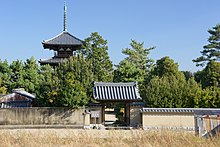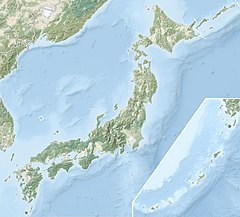|
Hokki-ji
 Hokki-ji or Hōki-ji (法起寺, the ‘temple of the Arising Dharma’)[1] – formerly known as Okamoto-dera (岡本寺) and Ikejiri-dera (池後寺) – is a Buddhist temple temple in the Okamoto neighborhood of the town of Ikaruga, Nara Prefecture, Japan. The temple's honorary sangō prefix is "Kōhonzan" (岡本山), although it is rarely used. The temple was constructed to honor Avalokitesvara, and an 11-faced statue of the goddess is the primary object of worship in the temple. Hokki-ji is often considered to be one of the seven great temples founded by Prince Shōtoku, but in fact the temple was not completed until some decades after his death. In 1993, it was registered together with Hōryū-ji as an UNESCO World Heritage Site under the name Buddhist Monuments in the Hōryū-ji Area. HistoryThe town of Ikaruga, where the World Heritage Site Hōryū-ji is located, was a center for early Japanese Buddhism, and the temples of Hokki-ji, Hōrin-ji and Chūgū-ji were founded in the 7th century, and claim a connection to Prince Shōtoku. Hokki-ji is located in the Okamoto district at the foot of the mountain northeast of Hōryū-ji's East Precinct. It is said that the temple lies atop the ruins of Okamoto no Miya (岡本宮) palace, wherein Prince Shōtoku had lectured on the Lotus Sutra, and that according to the prince's last will and testament, his son, Prince Yamashiro no Ōe rebuilt the former palace as a temple. Later, during the reign of Emperor Jomei (638), a Miroku Bosatsu statue was installed and a new main hall was completed, and in 706, the present three-story pagoda was completed. The temple was originally a nunnery, and as early as 747 it was listed in the Hōryū-ji Engi" listed by the name "Ikego-niji" as one of the "Seven Temples Built by Prince Shōtoku." The oldest document showing that Ikego-niji and Hokki-ji are the same temple is the Shichidaiki (written by Kyomei, a monk of Shitenno-ji) from 771, which says, "Hokki-ji was called Ikego-ji by people of the time". The temple was also called Okamoto-ji, and the earliest example of this is the "Tōdai-ji Temple Construction Office" (Shōsō-in documents) from 750. The 9th century collection of Buddhist tales, Nihon Ryōiki includes a miraculous tale about the Kannon statue at Okamoto-niji. Hokki-ji flourished during the Nara Period, but fell into decline during the Heian Period and was taken over by Hōryū-ji Temple. The three-story pagoda and lecture hall were repaired during the Kamakura Period, but it began to decline again during the Muromachi Period, and by the Edo Period, only the three-story pagoda remained. In 1678, the three-story pagoda was restored, and in 1694, the lecture hall was rebuilt. Archaeological excavations of the temple grounds conducted after 1960 have uncovered the remains of the foundations of the main hall and lecture hall, as well as the remains of a tiled foundation for the central gate, revealing the original layout of the temple complex at the time of its construction. The former temple complex has the main hall and pagoda lined up on the left and right (east and west), similar to the layout of the western precincts of Hōryū-ji, but as the main hall is built on the west and the pagoda on the east, which is the opposite of Hōryū-ji Temple, and this style is called the "Hokki-ji style temple complex layout." In addition, excavation revealed that the original structures were post-hole buildings (with no foundation stone, but wooden pillars placed in holes dug into the ground) and also a stone-paved rain gutter dating back to before the construction of the original temple complex, confirming the existence of some predecessor building before the founding of Hokki-ji, which is presumed to be Okamoto Palace. The original complex of Hokki-ji was built along a central north-south axis, facing south, but the predecessor building and gutter were built along an axis tilted about 20 degrees west from the north-south axis. The central axis of the building tilted about 20 degrees west is also common to the remains of the Wakakusa temple complex, the predecessor of Hōryū Temple. The grounds of the temple were designated a National Historic Site in 1993.[2]
Cultural properties
See alsoReferences
External links
Information related to Hokki-ji |
||||||||||||||||||||||||||||||||||||||||||||||||||
Portal di Ensiklopedia Dunia








